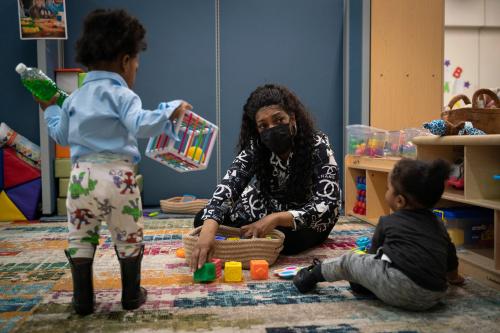Governments restrict many privileges and services to certain subsets of the population. The U.S. federal government, for example, limits voting rights to U.S. citizens and subsidized student loans to undergraduate students who demonstrate financial need.
These restrictions typically involve the government screening would-be recipients for their eligibility. However, eligibility screenings can create barriers that keep people from accessing the privileges to which they are entitled. Some of these barriers, like certain voter ID requirements, reflect deliberate attempts to keep certain eligible people out. Others are the product of bureaucracy—less nefarious in their origins, but still harmful in their effects.
In a newly released study, we look at the eligibility verification process for enrolling in early childhood education (ECE) programs in New Orleans. A New Orleans parent who wishes to obtain a publicly funded, tuition-free ECE placement for her child must demonstrate eligibility by producing a set of documents related to issues like family income and residency. Similar requirements exist for publicly funded ECE seats across the country.
Using an experimental text messaging intervention, we explored the barriers that low-income families confront during the ECE school choice process and how policymakers might better help them through those barriers. We found that a low-cost communications intervention can substantially increase the rate at which families complete the eligibility verification process and enroll in ECE programs.
Background: ECE enrollment in New Orleans
New Orleans has the country’s most choice-oriented school system. Virtually all public schools in New Orleans are charter schools, and children are not assigned to schools based on where they live. For families of children in K-12 grades, enrolling in school typically requires submitting a ranked list of school requests through the city’s unified enrollment system, the OneApp.
For applicants to publicly funded ECE programs (like Head Start and school-based pre-K programs), the enrollment process requires an additional step. After ECE applicants submit their ranked list of requests through the OneApp, applicants must present, in person, forms that establish the child’s eligibility for a publicly funded seat. The required documents can include pay stubs, to establish proof of income eligibility, and lease agreements or electricity bills, to establish proof of residency.
District officials indicated to us that many parents’ ECE enrollment processes have gotten derailed at this eligibility verification step. In 2016 to 2017, the year before our study, about 35% of the families who submitted an ECE application through the OneApp did not complete the verification process. These applicants expressed a desire to obtain a publicly funded ECE seat—by submitting a OneApp application—but lost their opportunity for a placement by not verifying.
A text messaging intervention to help parents through verification
In hopes of helping parents through the eligibility verification barrier, we collaborated with OneApp administrators to test strategies for helping parents through the process. We partnered with the district to randomly assign ECE applicants who had not yet verified eligibility to one of three groups.
- Group 1 (n=414 parents), the control group, received the district’s usual communications: weekly email reminders to verify and text message alerts about five weekend verification events.
- Group 2 (n=400) received these same communications plus weekly text reminders to complete the verification process. These messages were formal and bureaucratic in tone (e.g., “Your child’s OneApp is incomplete. The next step is to verify eligibility. Submit required documents to finish your OneApp.”).
- Group 3 (n=410) received the same communications as Group 2 but with a different tone and style. Group 3 messages were personalized, friendly, and encouraged two-way communication with a member of the district staff named Ashley (e.g., “Hi, it’s Ashley… I want to make sure [Child’s name] doesn’t lose her spot for next year! Text me if you’d like help finishing the OneApp!”).
We compared the rates at which applicants in these three groups (a) completed the verification process and (b) enrolled in an ECE program in the OneApp in the following fall. We also reviewed transcripts of the text message exchanges between applicants and staff to assess the challenges that parents experienced during the process.
Results
The Group 2 (formal) and Group 3 (informal) communications both produced large, statistically significant increases in verification rates. Compared to Group 1, these applicants were 7 to 8 percentage points more likely to complete the verification process.
Effects on verification were larger for pre-K applicants who did not apply to Head Start programs (12.6 to 14.5 percentage points) than for Head Start applicants.
Interestingly, after hypothesizing that effects might be larger with more personalized communications, we did not find significant differences between Groups 2 and 3 in verification rates. However, among pre-K applicants (those who did not apply to any Head Start programs), we found the highest enrollment rates for Group 3 (72.1%, compared to 62.0% for Group 1 and 65.5% for Group 2). Enrollment rates among Head Start applicants were not significantly different—which, as we explain in the paper, could reflect the Head Start application process being more complicated and Head Start applicants having additional needs.
Group 3 applicants responded to the texts at much higher rates than Group 1 and Group 2 applicants (89% of Group 3 responded to at least one text, compared to about 10% of the other groups). On one hand, this created more work for district staff, who found themselves engaging in two-way text message conversations with many Group 3 parents. On the other hand, these conversations provided a real-time look at the types of challenges that parents confronted. Transcripts of these conversations revealed that many parents misunderstood aspects of the verification process such as where to take their documents and what, exactly, to bring.
Implications
Consistent with research on other topics like FAFSA completion, we find that many families who would like access to a publicly funded resource—in this case, a tuition-free ECE placement—get sidetracked during the eligibility verification process. For low-income parents of young children in New Orleans, this can be consequential. It can keep their children from obtaining the benefits of a high-quality early childhood education—and keep parents from accessing a program that fits their work and family needs. Moreover, since many popular elementary schools begin in pre-K and allow pre-K students to continue into kindergarten, waiting a year to request an elementary school seat could keep a family from getting in.
Policymakers who oversee programs with eligibility verification requirements should take a close look at those requirements and consider the barriers they might create, particularly for certain populations (e.g., individuals in poverty and nonnative English speakers). Perhaps the first question to ask is whether that requirement is needed at all. If it is, then finding ways of making these requirements less burdensome or intimidating can help individuals receive the resources and services to which they are entitled.








Commentary
Can text messages help families applying for early childhood education programs?
April 16, 2019